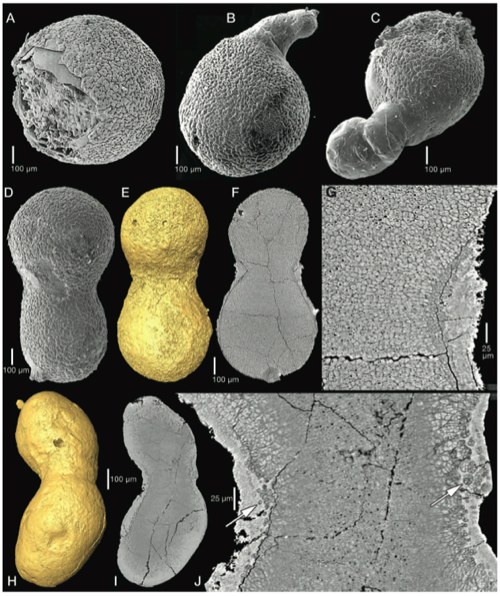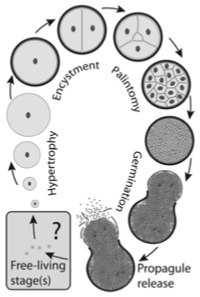I’ve written about the spectacular phospatized embryos of the Doushantuo formation before. It’s a collection of exceptionally well preserved small multicellular organisms, so well preserved that we can even look at cellular organelles. And they’re pre-Cambrian, as much as 630 million years old.
They’ve been interpreted as fossilized embryos for which we have no known adult forms. They certainly look like embryos, but one thing has always bothered me — they all look like blastula-stage embryos at various points in their early divisions, and the absence of later stages was peculiar: how did gastrulae and neurulae and other stages avoid getting preserved?
One explanation was that we weren’t seeing metazoan fossils at all — they were colonies of large bacteria. That’s disappointing if you have an animal bias, but still cool — as I pointed out then, it just highlights the fact that the transition from single-celled to multi-celled life isn’t that remarkable.
Now we have another alternative explanation that seems even better to me: they aren’t animals, and they aren’t bacteria, they’re protists. Some of the Doushantuo specimens are rather peanut-shaped, and others are vermiform, odd for an animal embryo, but entirely compatible with the idea that these are encysted stages of propagating protists.
Here are some of these oddly shaped Doushantuo specimens.

Tianzhushania from the Ediacaran Doushantuo Formation, Datang Quarry, Weng’an, Guizhou Province, China. (A) Regular and (B to J) irregular forms, the latter interpreted to be in the germinating stage: MESIG 10022 [(A) SEM micrograph]; MESIG 10023 [(B) SEM micrograph (19)]; MESIG 10024 [(C) SEM micrograph (19)]; MESIG 10021 [(D) SEM micrograph]; SMNH X 4447 [(E) to (G) srXTM renderings]; SMNH X 4448 [(H) to (J) srXTM renderings]. (A) Surface of regular globular specimen shows envelope structure, to be compared with the similar envelope structure in (B) to (D). [(B) and (C)] Germinating specimens show protruding tubes and envelope structure. (D) Peanut-shaped specimen shows envelope structure. (E) Isosurface rendering of peanut-shaped specimen. (F) Orthoslice through (E). (G) Detail of approximate level in (F), showing cellular units. (H) Isosurface rendering of peanut-shaped specimen. (I) Orthoslice through (H). (J) Detail of approximate level in (I), showing cellular units. There is a progressive individuality of cellular units toward the periphery, including detachment of single- and oligocellular units (arrows).

Proposed life cycle of Tianzhushania through hypertrophic growth of mother cell, encystment in multilayered wall, palintomic cleavage resulting in a tightly packed mass of pre-propagules, germination by opening of outer cyst wall, and release of prop- agules by degradation of inner cyst wall. Shown is the role of the outer and inner cyst walls in forming the peanut-shaped germination stages (see also modern mesomycetozoean examples in fig. S7). The outer cyst wall (seldom preserved) is indicated in black; the inner cyst wall dark is indicated in gray.
Their proposed explanation convinces me. These were protists that were single-celled in their free-living stage which would periodically grow hypertrophically and encyst, forming a capsule containing the dividing cells. These cells would replicate at differnt rates, forming zones of maturation; eventually, the cyst would rupture, released a cloud of propagules, or spores, and the life cycle would begin again.
That would explain a lot about the distribution of forms in these phosphatized specimens — we don’t find any gastrulating embryos because there never were any. These weren’t animals, period!
They belong outside crown-group Metazoa, within total-group Holozoa (the sister clade to Fungi that includes Metazoa, Choanoflagellata, and Mesomycetozoea) or perhaps on even more distant branches in the eukaryote tree. They represent an evolutionary grade in which palintomic cleavage served the function of producing propagules for dispersion.
That’s still very interesting, and again, it reminds us that the transition to multicellularity had many antecedents and could have been reached by many different paths.
Huldtgren T, Cunningham JA, Yin C, Stampanoni M, Marone F, Donoghue PC, Bengtson S (2011) Fossilized nuclei and germination structures identify Ediacaran “animal embryos” as encysting protists. Science 334(6063):1696-9.
(Also on Sb)


I eagerly anticipate a followup paper on what songs the sirens sang. It’s mindblowing that this knowledge can be obtained.
I wonder if maybe these ancient protists were proto slime molds, if not slime molds. We need specimens in a loosely aggregated state, much like slime molds of today.
Our fellow pond scum.
I’m just sorry they didn’t make it, but then, not too many did. It’s cool that, although our ancestors weren’t interested when they were alive, their descendants get to know a considerable amount about them.
Glen Davidson
Future magazine cover:
“Missing Ling Between Animals And Microbes Found — Creationists Baffled.”
;^)
As it happens, one of my current projects is writing notes for a science fiction novel I’m working on, specifically a part describing what life on other planets might look like. I can easily see something like this on, say, Mars:
When conditions are right, the cyst breaks down and the spores are released; the spores mature and possibly go through a genetic exchange phase with other mature cells (evolutionary advantage: only those who find current conditions favorable would be available); when conditions start to become less favorable, they envelop a mineral grain that can be used for raw materials and encyst; they “digest” the grain and build new spores; the whole cyst goes dormant until environmental conditions change again.
Or on a distant body like Pluto or Sedna: near periapsis, the spores would emerge and go through their life cycle (slowly, because of the tiny amount of available solar energy, but they’d have decades), encysting again as the body moved back into the deep system.
There were some that were specifically described as gastrulas, in fig. 3 here. Not disputing the new interpretation, but couldn’t some be protists and some be embryos?
We certainly have critters that act like this, but they’re mostly funguses. And these aren’t much different than finding bacterial nodules that grow on trees or in the soil. So I don’t think it’s surprising the niche existed hundreds of millions of years ago. ^-^
I don’t really understand why we thought they were embryonic.
Awesome name, and awesome that this clade now has a name!
Even more awesome that this life cycle could be homologous to metazoan multicellularity. First thing in the morning tomorrow, I’ll download the paper and the supplementary information and have a good look at fig. S7…
Slime mold “larvae” don’t grow from a single cell, let alone a cell that first bloats beyond belief and then subdivides.
(And they aren’t holozoans.)
At the risk of sounding like Mr Spock: fascinating, PZ.
I’m fairly sure E IS a peanut.
What do we know about the transition from single celled organisms to multi-cellular organisms? That has always seemed like a fascinating step in our evolutionary history to me; can you do a post on that topic? And/or on abiogenesis, which also seems cool and largely mysterious?
Andy Knoll has a nice new review on the multiple origins of multicellularity:
Knoll, A. 2011. The Multiple Origins of Complex Multicellularity. Annual Review of Earth and Planetary Sciences 39: 217-239 (Volume publication date May 2011) DOI: 10.1146/annurev.earth.031208.100209
Because the only things that are still around today that do what these things evidently did–start with one huge cell and divide repeatedly without cell growth to form a globular cluster, then a hollow ball of cells, still about the size of the original cell–are animal embryos.
a LOT like embryos, some of them, for the reasons just mentioned
I guess you mean cleavage stages prior to the blastula? Yeah, thanks to Carlie for saving me the g**gling time, but do check out the article and figure she linked for another view. They sure look like gastrulae to me, and I’ve seen some recently. *shrug*
Carlie also raised a good question: why the assumption that everything found in these deposits is the same thing?
And I too like the name Holozoa. Whatever these things were (unresolved, imo).
Casey Luskin’s comments on this paper:
It’s not correct to say that with the exception of the Ediacaran biota all we find is single-celled organisms in the
late Neoproterozoic. For example, the time-equivalent Miaohe biota in China is full of multicellular alga-like forms. Multicellularity is a multifaceted thing. It has appeared a number of times in the history of life.
There are some other fossils known from the deposit, such as Sinocyloclycicus and Eoandromeda – the latter thought (optimistically) to be a ctenophore.
‘In the middle of the fungi and the animals’
I wonder if maybe these ancient protists were proto slime molds, if not slime molds. We need specimens in a loosely aggregated state, much like slime molds of today.
Phil Donoghue gave a talk on this research at my University this autumn. He did talk about slime moulds. Unfortunately I can’t remember why: it may just have been that he thought they were cool, and a well known group of protists
Slime molds are totally cool as examples of how the evolution of multicellularity might get started sometimes, under certain circumstances. They have little to tell us about the evolution of multicellular animals specifically, however. They are not close to animals phylogenetically–the genetic evidence is clear on this point–nor are their typical ecological situations anything like those of proto-animals, but nevertheless mythusmage won’t leave his hobbyhorse alone.